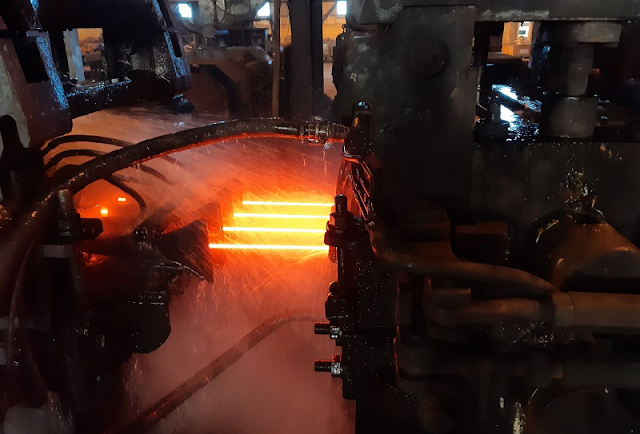Metallurgical Slitting Rolling Technology
Whether the rolled piece can be cut is not only related to the thickness of the connecting part and the relative reduction but also closely related to the pass shape and the size of the slit rolling. In the pass design of the slitting process, the design of pre-cutting and slitting holes is particularly important, followed by the vertical box pass. The pass design of these passes is related to the success of slitting and rolling.
The pre-cut split hole is a transitional pass to ensure the smooth slitting of the split hole. Its purpose is to reduce the unevenness of the split pass, so that the splitting wedge can complete the pressing and positioning of the opposite rolling piece, and accurately distribute the rolling. The cross-sectional area of the piece reduces the burden of cutting the hole as much as possible, thereby improving the stability and uniformity of the cutting. The design should have sufficient reduction, the elongation coefficient should be 1.3 to 1.4, the expansion coefficient should be about 0.6, and the height of the connecting belt should be 0.45-0.48 times the height of the hole.
The slitting hole is basically formed by the connection of a double round pass and a slitting wedge. The function of the slitting pass is that the slitting wedge continues to press down the middle of the pre-slit rolling piece, rolling out the same shape as the pass Rolled pieces, so that the thickness of the connecting strip meets the needs of tearing apart multiple rolling pieces in parallel. In the process of slitting and rolling, due to the effect of the slitting wedge, the limitation of the non-porous side wall on both sides of the rolling piece in the slitting pass, and the rolling piece has a more complex cross-sectional shape, the changes of the rolling piece are as follows: Different from conventional rolling. Its main features are as follows. Severe uneven deformation. The compression deformation at the cutting wedge is often greater than that of other parts.
Splitting deformation is no extension or small extension deformation. When slitting the rolled piece in the slitting hole, the reduction at the bottom of the groove is small, while the reduction at the slitting wedge is larger, and the metal is subjected to the action of the slitting wedge, and the horizontal component force pointing to the widthwise direction is larger. It is a forced widening deformation, so the overall extension is small and the widening is larger.
When multiple roots are divided, the cross-sections of the rolling pieces in the middle and the sides are different, and the width of the rolling pieces on both sides is large and the extension is small; the head and middle dimensions of the rolling piece are also different, and the width of the head and tail is widened. The wedge angle of the slitting hole should be reasonable. If it is too small, it will not cut cleanly or cut. If it is too small, it will cause too much clamping force on the slitting wheel and increase the load of the slitting wheel, generally 60°-65°; The rounded corner of the tip is preferably 1~1.5mm. Too sharp will accelerate the wear of the roll; the thickness of the connecting belt should be close to the gap of the roll, 1-2mm is best; the elongation coefficient is 1.08~1.15, and a certain amount is reserved. Broad room for expansion.
Please contact stella@hanrm.com for a quotation.
And free send inquiry to us.
Email: stella@hanrm.com stellarollingmill@gmail.com
Whatsapp/Wechat:+8615877652925
More News You May Interesting:
Finishing Rolling Mill Process Explanation
Reasons and Solutions for the Piling of Wire Rod Rolling
Characteristics and Quality of Wire Rod
Morgan Wire Rod Mill
Why does the Steel Bar Bend after being Cut by Flying Shear?
Headless Welding Rolling Process
Bar Rolling Mills Water Cooling Technology
How to Improve the Thermal Efficiency of the Reheating Furnaces?
Causes of Surface Cracks in High-Speed Wire Rod Rolling Mill
What is Slit Rolling?
Failure Analysis of Cold Mill Roll
Causes and Solution of Steel Piling-up in High-speed Wire Rod Rolling Mills?
Bar Automatic Counting System
Rolling Mill Pass Design
















